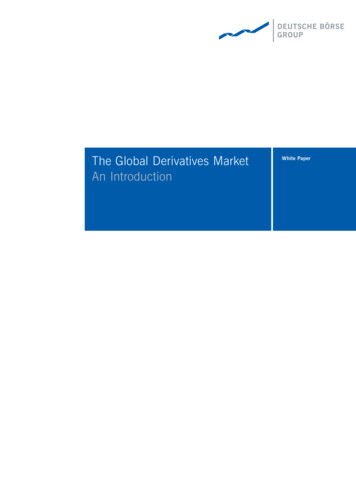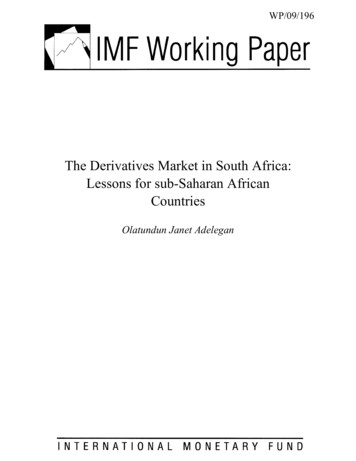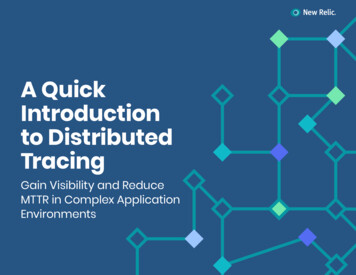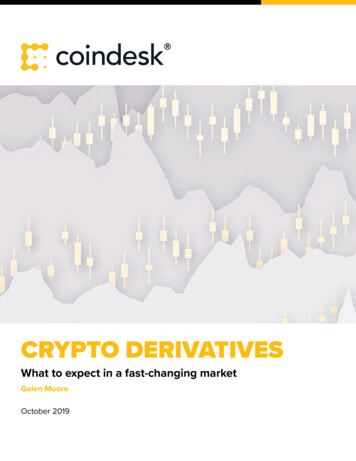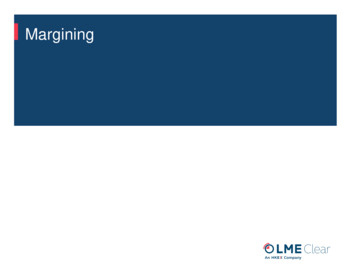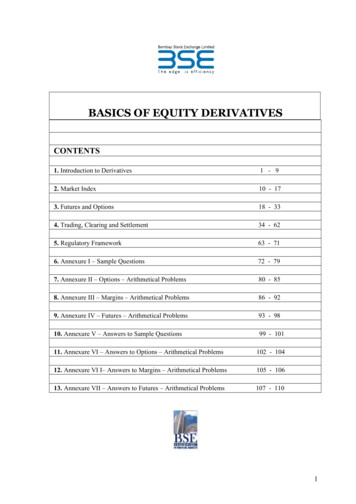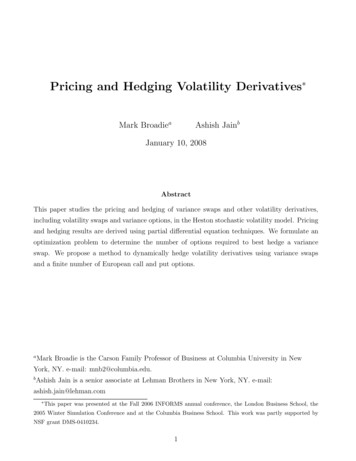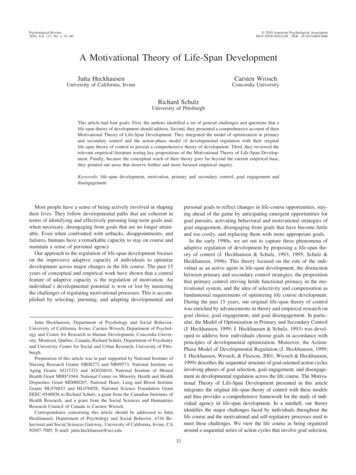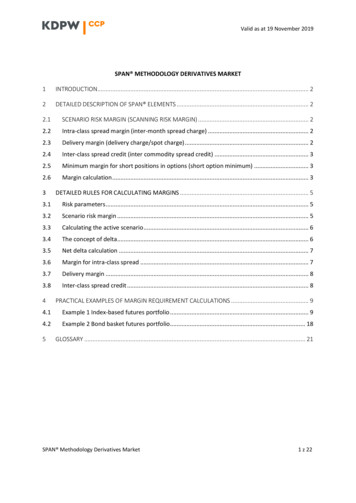
Transcription
Valid as at 19 November 2019SPAN METHODOLOGY DERIVATIVES MARKET1INTRODUCTION. 22DETAILED DESCRIPTION OF SPAN ELEMENTS . 22.1SCENARIO RISK MARGIN (SCANNING RISK MARGIN) . 22.2Intra-class spread margin (inter-month spread charge) . 22.3Delivery margin (delivery charge/spot charge) . 22.4Inter-class spread credit (inter commodity spread credit) . 32.5Minimum margin for short positions in options (short option minimum) . 32.6Margin calculation . 33DETAILED RULES FOR CALCULATING MARGINS . 53.1Risk parameters . 53.2Scenario risk margin . 53.3Calculating the active scenario . 63.4The concept of delta. 63.5Net delta calculation . 73.6Margin for intra-class spread . 73.7Delivery margin . 83.8Inter-class spread credit . 84PRACTICAL EXAMPLES OF MARGIN REQUIREMENT CALCULATIONS . 94.1Example 1 Index-based futures portfolio . 94.2Example 2 Bond basket futures portfolio. 185GLOSSARY . 21SPAN Methodology Derivatives Market1 z 22
Valid as at 19 November 20191INTRODUCTIONThis document presents an overview of the method used to calculate margin requirements for thederivatives market based on SPAN methodology.A portfolio is defined as a set of positions entered on the clearing account of a given clearing member.The calculation of margins using SPAN methodology for derivatives is performed by determining theincrease or the fall in the value of the portfolio taking place under a pre-defined market scenarioinvolving a price change and price volatility of the underlying instrument. A scenario involving thelargest fall in the value of the portfolio is the basis used for calculating the required margin.Risk scenarios recognise the influence of: Price changes of the underlying instrument Price volatility of the underlying instrument Changes to the option price as a result of a change in the time left to expiryThe final margin requirement is determined on the basis of the following partial calculations:- scenario risk margin- intra-class spread margin- delivery margin- inter-class spread credit- minimum margin for short positions in options2DETAILED DESCRIPTION OF SPAN ELEMENTS2.1 Scenario risk margin (scanning risk margin)The margin for scenario risk, calculated on the basis of analysis of the changes affecting the value ofthe portfolio within a given class under separate risk scenarios, is equal to the value of the risk in theworst-case market scenario (in SPAN convention, this is the scenario with the highest added riskvalue).2.2 Intra-class spread margin (inter-month spread charge)The process used to determine the value of margins for risk scenarios, it is assumed that maturityprices within a given instrument class are perfectly correlated. In reality, this is not the case. It istherefore essential to calculate a special margin which enables a different correlation for maturityprices to be formed.2.3 Delivery margin (delivery charge/spot charge)The delivery margin is used to secure against the additional risk involving the settlement oftransactions with the physical delivery of the underlying instrument.SPAN Methodology Derivatives Market2 z 22
Valid as at 19 November 2019This margin may also be used for spread positions cleared in cash with varying expiry dates, for whichone leg is close to the expiry date. In such cases, this margin ensures additional protection in cases ofunsecured positions in the remaining spread legs.SPAN methodology distinguishes two different delivery margins: Margin calculated for positions within the spread with other positions Margins calculated on unsecured positionsWhen calculating the delivery margin, positions for which the underlying instrument has been blockedon the delivery account of the clearing agent are not recognised.2.4 Inter-class spread credit (inter commodity spread credit)Since relatively strong correlations may exist between classes of instruments, credit may be assignedfor certain pairs of positions in various classes.Holding opposite positions in these classes may lead to a reduction in risk across the whole portfolio.2.5 Minimum margin for short positions in options (short option minimum)Portfolios holding short positions in options contain some residual risk. This margin ensures that therequired margin securing the portfolio cannot be set at a lower rate than the level of the KDPW CCPdetermined limit.The value of the minimum margin for short positions in options ( mdko )is calculated as follows:Formula 1-1mdkopk kopk dmkkodm- number of short options positions- minimum margin for a single short options position- portfolio index- class indexpk2.6 Margin calculationThe margin securing against the risk of a change in value of instruments in a portfolio in a given classDZWpk in a assumed time horizon is calculated as the total of the scenario risk margin, the intra-classspread margin and the delivery margin less the inter-class spread. The value of the margin calculatedin this way cannot however be smaller than the value of the minimum deposit for short optionspositions in this portfolio.Formula 1-2𝐷𝑍𝑊𝑝𝑘 𝑚𝑎𝑥{𝑑𝑟𝑠𝑐𝑝𝑘 𝑑𝑠𝑤𝑘𝑝𝑘 𝑑𝑑𝑝𝑘 𝑐𝑠𝑝𝑘𝑝 ; 𝑚𝑑𝑘𝑜𝑝𝑘 }drsc- scenario risk marginSPAN Methodology Derivatives Market3 z 22
Valid as at 19 November 2019dswkddcspkmdkopk- margin for intra-class spread- delivery margin- inter-class spread credit- minimum deposit for short options positions- portfolio index- class indexThis margin only secures against the risk of price change; in order to calculate the initial margin for theportfolio within a given class, the value of the net options positions needs to be subtracted from themargin calculated.Formula 1-3𝐷𝑍𝐾𝑝𝑘 𝑚𝑎𝑥(𝐷𝑍𝑊𝑝𝑘 𝑃𝑁𝑂𝑝𝑘 ; 0)DZKpk- margin securing against risk in portfolio p and class k of a given clearing memberPNOpk- value of net options positions (number of positions multiplied by the options price)In those instances where the value (𝐷𝑍𝑊𝑝𝑘 𝑃𝑁𝑂𝑝𝑘 ; 0) is positive, it forms a margin requirementfor a given class within the portfolio. In situations where the value (𝐷𝑍𝑊𝑝𝑘 𝑃𝑁𝑂𝑝𝑘 ) is negative, thisvalue is separated as 𝑁𝑂𝐷𝑝𝑘 and will be used to lower the margin requirement in other classes withina given portfolio.Formula 1-4𝑁𝑂𝐷𝑝𝑘 𝑚𝑖𝑛(𝐷𝑍𝑊𝑝𝑘 𝑃𝑁𝑂𝑝𝑘 ; 0)𝑁𝑂𝐷𝑝𝑘 - excess value of long options positions in portfolio p and class kThe value of the required margin DZP for portfolio p of a given clearing member is a maximum valueof the difference between the sum of the margins in each class and the sum of the excess of the longpositions calculated for all classes and zero.Formula 1-5𝐷𝑍𝑃𝑝 max { 𝐷𝑍𝐾𝑝𝑘 𝑁𝑂𝐷𝑝𝑘 ; 0}𝑘𝑘This allows the offset of margins within a single class through a positive value of net options positionsin another class.The value of the required margin DZU for a given clearing member is the sum total of the values ofthe required margins for each of the clearing member’s portfolios.Formula 1-6𝐷𝑍𝑈 𝐷𝑍𝑃𝑝𝑝SPAN Methodology Derivatives Market4 z 22
Valid as at 19 November 20193DETAILED RULES FOR CALCULATING MARGINS3.1 Risk parametersCalculating margin requirements using SPAN methodology takes place using risk parameterscalculated each day by KDPW CCP on the basis of updated risk analysis. KDPW CCP publishes on adaily basis a file containing in particular the values of the risk scenarios for each long position in eachinstrument, as well as:- the delta value for each instrument- the price variation- the volatility variation- option reference volatility- risk free interest rate- dividend rate- level of minimum deposit for short options positions- level definitions- intra-class spread definitions- inter-class spread definitions- delivery margin3.2 Scenario risk marginSPAN analyses changes in the portfolio value according to 16 scenarios of price and volatilityvariation.Table 2-1 Risk scenario definitionsScenario no.Underlying price 600 1/3 1/3-1/3-1/3 2/3 2/3-2/3-2/3 1 1-1-1 3-3 1-1 1-1 1-1 1-1 1-1 1-1 1-100SPAN Methodology Derivatives MarketProfit/loss fraction takeninto 00%100%100%100%100%100%32%32%5 z 22
Valid as at 19 November 2019The value of the risk under a given scenario is calculated as the difference between the theoretical andthe market price of the instrument multiplied by the relevant weight.The theoretical value of an instrument is calculated by determining a pre-defined timescale and pricevariation of the underlying instrument and its volatility under a given risk scenario. In order to calculatethe theoretical value of the option, the relevant pricing model is used.In certain instances, KDPW CCP may use the theoretical price of the option instead of the market priceto calculate the actual value of the option, assuming the same pricing model, the actual time to expiry,the actual value of the underlying instrument and the correct interest rate.In order to calculate risk scenarios for futures, only the impact of the price variation is factored in;however, for options, both price variation and volatility variation, as well as the time scale are includedin the calculation.All parameters of the model are updated and made available by KDPW CCP.3.3 Calculating the active scenarioThe scenario risk margin is equal to the greatest positive risk value calculated from among all 16scenarios. A scenario calculated in this manner is called the active scenario.Where there are several instruments that form part of the portfolio, the portfolio risk under a givenscenario is calculated as the total of the risks for each instrument within a given scenario.In instances where more than one scenario gives the same positive risk value in its result, then thescenario risk margin is deemed to be the portfolio value under the scenario with the lowest number.Where there is no scenario with a positive value among the 16 risk scenarios, then the margin forscenario risk is assumed to hold a value of zero.Note: scenarios contain only risk values; only at a later stage is the risk value adjusted with the netvalue of the options that are in the portfolio.3.4 The concept of deltaIn order to harmonise the approach to margin calculation for futures and options, delta calculationsneed to be made. The delta is the level of price sensitivity of a derivative instrument to price changesof the underlying instrument.The delta is calculated to determine the following:- the intra-class spread margin- the delivery margin- the inter-class spread marginThe delta for each long position is defined as follows:- for call options – from 0 to 1- for put options – from -1 to 0- for futures – 1SPAN Methodology Derivatives Market6 z 22
Valid as at 19 November 20193.5 Net delta calculationThe value of the delta for each position is calculated by multiplying the number of positions by areference delta value determined by KDPW CCP for a given instrument and the delta scaling factor.The purpose of the scaling factor is to level out the differences between the nominal values of thecontracts.Each position expressed in the delta is aggregated to a predefined future month.For futures, the delta is aggregated to the expiry date of the contract, while for options, the delta isaggregated either to option expiry date, or the expiry date of the underlying instrument.A net delta value is calculated for each separate future month as the sum total of deltas of all positionsfor a given month.The concept of delta is related to the concept of level. The level is a range of several expiry months,for example: 2006-01, 2006-02, 2006-03. For each level, a positive and a negative delta value iscalculated (the sum total of positive deltas and the sum total of negative deltas). The purpose ofcreating levels is to determine groups of future expiry months which are similar in terms of risk, whichwill enable a lower number of spreads to be defined and processed.3.6 Margin for intra-class spreadThe intra-class spread is commonly reflected by two opposite positions (expressed in the delta) heldin derivatives within a given class (spreads containing more than two legs are also possible). For aspread to be generated, positions need to belong to levels specified within the spread definitionprepared by KDPW CCP.When calculating the scenario risk margin, the principle that final prices are perfectly correlated isapplied. SPAN recognises this principle and assumes that the risk inherent in a long position in a givenmonth is fully offset by the risk inherent in a short position in another future month.The reality, however, is different. Losses on a position expiring in one month in the future do not haveto be precisely offset by profits from a position expiring in another month. This additional risk issecured by the margin for intra-class spread.The definition of the spread determined by KDPW CCP contains a definition of each leg of the spread,their market side (long or short position), the level of the margin for the spread, the delta number fora given leg of the spread and the spread priority.The first spread generated is assigned priority 1, then 2, 3 etc. The spread margin is calculated for thevalue of the positions creating the spread expressed in the delta.For example: if leg 1 of the spread contains five negative delta values, leg 2 of the spread containsseven positive delta values, while the spread definition specifies that one delta from each level isneeded to create it, then the following spread may be created: min( -5 ; 7 ) 5.SPAN Methodology Derivatives Market7 z 22
Valid as at 19 November 2019The value of the spread used to create the previous spread is deducted from the available delta valuesfor each subsequent spread.3.7 Delivery marginThe delivery margin is used to secure against the additional risk for derivatives where settlement takesplace through the physical delivery of the underlying instrument.SPAN methodology enables the differences between the risks to be recognised in instances where:- unsecured positions settled by delivery are being held- positions settled by delivery are being held that are in the spread with other positionsKDPW CCP begins calculating the higher margin starting from the first day of the week in which thecontract expires.The margin for delivery is calculated for the value of the delta of positions settled through delivery.3.8 Inter-class spread creditThe inter-class spread credit enables risk to be reduced where opposite positions are held in separateclasses, however with similar risk features of the underlying instrument. KDPW CCP determines thedefinition of the spread containing a description of the separate legs of the spread, their market side,the delta number for a given leg of the spread, the credit rate and the spread priority.The SPAN algorithm enables the credit to be calculated based on the price variation risk of theinstrument. The price variation risk is calculated on the basis of the following factors:Formula 2-1Scenario risk price variation risk volatility risk time riskThe value of price variation risk is calculated by reformulating the equation, i.e., subtracting volatilityrisk and time risk from the given scenario risk.The value of volatility risk is eliminated by finding a scenario paired with the active scenario numberfor a given class. Scenarios are paired so that each assumes an identical price change direction,however the opposite volatility change direction.Scenarios 15 and 16 are paired with themselves since neither assumes a change of volatility.Table 2-2 Scenario pairsRisk scenario no.12345678910 11 12 13 14 15 16Paired scenario2143658710 912 11 14 13 15 16E.g., if Scenario 13 is the active scenario, then the paired scenario is Scenario 14.The value of scenario risk adjusted for volatility risk is obtained as follows:Formula 2-2SPAN Methodology Derivatives Market8 z 22
Valid as at 19 November 2019Scenario risk adjusted for volatility risk (active scenario risk paired scenario risk)/2Time risk is also calculated on the basis of risk scenarios. It should be noted that Scenarios 1 and 2 donot envisage price changes to the underlying instrument, only changes in volatility. By taking the meanrisk value from Scenarios 1 and 2, volatility risk is eliminated (these are paired scenarios) and only puretime risk is left. Time risk can then be calculated using the following formula:Formula 2-3Time risk (Scenario 1 risk Scenario 2 risk)/2The final price variation risk can be calculated according to the following formula:Formula 2-4Price variation risk scenario risk adjusted for volatility risk – time riskIn order to calculate the value of the credit, the unit price variation risk will also need to be calculated.This is determined by dividing the value of price variation risk by the total value of the net delta withina given class.Formula 2-5Unit price variation risk price variation risk / total net deltaThe value of the credit is assigned in relation to the value of the delta within the interclass spread. Inorder for the interclass spread to be created, the delta in the spread must have the market side definedfor the spread by KDPW CCP.The final value of the credit for a given class is calculated on the basis of the following formula:Formula 2-6Value of the credit unit price variation risk x delta within the spread x number of deltas per spread xcredit rateThe credit is calculated in relation to each leg forming the spread.4PRACTICAL EXAMPLES OF MARGIN REQUIREMENT CALCULATIONS4.1 Example 1 Index-based futures portfolioPortfolio A- 5 short positions in FW20H6 futures- 6 long positions in FW20M6 futures- 1 long position in FW20U6 futures- 4 long positions in OW20C6290 call options (strike price 2900), premium 116- 10 short positions in OW20C6300 call options (strike price 3000), premium 63- 1 short position in FMIDM6 futuresSPAN Methodology Derivatives Market9 z 22
Valid as at 19 November 2019The margin calculation begins with determining the total risk value for the positions under a givenscenario. The risk scenarios published by KDPW CCP are used for this purpose. The risk scenarioscontain risk values for a single long position. In order to obtain the actual risk values for positions inthe portfolio, the risk value published by KDPW CCP should be multiplied by the number of positionsin a given instrument.Table 3-1 Calculating risk scenarios for positions within a portfolioOW20C6300Scenario noRisk in a single longpositionNumber ofpositionsTotal risk[1][2][3] [2] x [1]1-191-101 9102209-10-2 0903-429-104 2904-12-10120510-10-1006373-10-3 7307-704-107 0408-294-102 9409175-10-1 75010484-10-4 84011-1015-1010 15012-632-106 32013306-10-3 06014554-10-5 54015-1081-1010 81016200-10-2 000SPAN Methodology Derivatives Market10 z 22
Valid as at 19 November 2019Table 3-2 Calculating the margin for scenario risk for a portfolioScenario no.Price 0U6OW20C6290OW20C6300W20 classFMIDM6MID class1011000-7521 9101 158,000020-11000840-2 090-1 250,000030.33112 500-3 000-500-1 9924 2901 298,0036736740.33-112 500-3 000-500-500120-1 380,003673675-0.3311-2 5003 000500344-1001 244,00-367-3676-0.33-11-2 5003 0005001 960-3 730-770,00-367-36770.67115 000-6 000-1 000-3 3607 0401 680,0073373380.67-115 000-6 000-1 000-2 0242 940-1 084,007337339-0.6711-5 0006 0001 0001 300-1 7501 550,00-733-73310-0.67-11-5 0006 0001 0002 852-4 84012,00-733-733111.00117 500-9 000-1 500-4 84810 1502 302,001 1001 100121.00-117 500-9 000-1 500-3 7046 320-384,001 1001 10013-1.0011-7 5009 0001 5002 108-3 0602 048,00-1 100-1 10014-1.00-11-7 5009 0001 5003 516-5 540976,00-1 100-1 100153.0000,327 200-8 640-1 440-4 89210 8103 038,001 0561 05616-3.0000,32-7 2008 6401 4401 460-2 0002 340,00-1 056-1 056SPAN Methodology Derivatives Market11 z 22
Valid as at 19 November 2019In portfolio A, 2 classes of instruments can be distinguished: W20 and MID. The active risk scenario(i.e., the scenario containing the greatest loss) is Scenario 15 for the W20 class and Scenario 11 forclass MID. The margin to cover scenario risk for both classes will therefore be set at PLN 3,038 and PLN1,100 respectively.In order to calculate the other components of the margin requirement, the value of the delta in eachlevel will need to be determined. The value of the delta in each level is calculated on the basis ofinformation on the value of the reference delta for each instrument published by KDPW CCP, as wellas on the basis of level definitions.Table 3-3 Reference delta values for each instrument within the 2901OW20C63000.591014FMIDM60.419551Table 3-4 Level definitions for W20 classLevel no.No. of subsequent expiry monthLevel 11 (futures)Level 22 (futures)Level 33 (futures)Level 4optionsFutures contracts are assigned to levels on the basis of their expiry dates while options are assigned tolevels that cover the so-called underlying month. This means in practice that all index-based optionsare assigned to a level which covers the technical “month” – “999999”.On the basis of this information, the value of the delta for each month is calculated. E.g., the value ofthe delta for OW20C6290 is obtained by multiplying the number of positions (4) by the value of thedelta (0.591014) and by the delta scaling factor (4 x 0.591014 x10 23.6406).The delta scaling factor takes into account potential differences in the nominal value of futurescontracts.Table 3-5 Calculating the delta for each monthName of instrumentFW20H6FW20M6FW20U6Delta month200603200606200609999999999999200606Delta scaling factor101010101010Delta value-50601023.6406-41.9550-10SPAN Methodology Derivatives MarketOW20C6290 OW20C6300 FMIDM612 z 22
Valid as at 19 November 2019In the next step, the value of the net delta in each month is calculated. Here is an example of calculationfor “level 4”.999999: 23.6406 (-41.9550) 18.3144Following the calculation of the net deltas for each month, the total of net positive deltas and the totalof net negative deltas for each level is calculated.The values of the deltas allocated to each level for the W20 class are as follows:Table 3-6 Delta in levelsW20 classLevel no.Positive deltaLevel 1Negative delta-50.0000Level 260.0000Level 310.0000Level 4-18.3144The value of the margin for intra-class spread is calculated using the spread definition.Table 3-7 Intra-class spread definitionClassW20PriorityLeg 1Market sideLeg 2Market 4B2551N2A1N4B2561N3A1N4B25The spreads need to be created according to pre-defined priorities only. A delta “used” to create aspread lowers the value of the delta available for spreads with lower priorities. The notation “1N1”means that in order to create a leg of a spread, 1 delta from level 1 will need to be used. The notation“1N2” means that in order to create a leg of a spread, 1 delta from level 2 will need to be used, and soforth. A spread may be created when the deltas in each leg of the spread are situated on specificmarket sides. In such instances, if one leg of the spread is a positive position in the delta, then theother leg must be a negative position, and vice versa, which corresponds to the designated symbols Aand B.Table 3-8 Delta in the spreadSPAN Methodology Derivatives Market13 z 22
Valid as at 19 November riority6Leg 1-50.0000Leg 10.0000Leg 110.0000Leg 10.0000Leg 110.0000Leg 110.0000Leg 2Delta in the spread60.000050.0000Leg 2Delta in the spread10.00000.0000Leg 2Delta in the spread10.00000.0000Leg 2Delta in the spread-18.31440.0000Leg 2Delta in the spread-18.314410.0000Leg 2Delta in the spread-8.31448.3144For priority 1, both legs of the spread are on opposite market sides and it is possible to create thefollowing spread:Min( -50.0000/1 ; 60.0000/1 ) 50.0000.At the same time, the value of the delta available to create subsequent spreads will be:For level 1: -50.0000 - (- 50.0000) 0For level 2: 60.0000 – 50.0000 10.0000For priority 2, the first leg of the spread has a delta value of 0.0000 while the second leg has a value of10.0000. It is therefore not possible to create a spread.SPAN Methodology Derivatives Market14 z 22
Valid as at 19 November 2019For priority 3, the first leg of the spread has a delta value of 10.0000 while the second leg also has avalue of 10,0000. It is therefore not possible to create a spread.For priority 4, the first leg of the spread has a delta value of 0.0000 while the second leg has a value of-18.3144. It is therefore not possible to create a spread.For priority 5, the first leg of the spread has a delta value of 10.0000 while the second leg has a valueof -18.3144 and it is therefore possible to create the following spread:min( 10.0000/1 ; -18.3144/1 ) 10.0000At the same time, the value of the delta available to create new spreads will equal:For level 2: 10.0000 – 10.0000 0For level 4: -18.3144 - (-10.0000) -8.3144For priority 6, the first leg of the spread has a delta value of 10.0000 while the second leg has a valueof -8.3144 and it is therefore possible to create the following spread:min( 10.0000/1 ; -8.3144/1 ) 8.3144.At the same time, the value of the delta available to create new spreads will equal:For level 3: 10.0000 – 8.3144 1.6856For level 6: - 8.3144 - (-8.3144) 0The final value of the intra-class spread margin for the W20 class is calculated as follows:50.0000 x 20 0.0000 x 25 0.0000 x 25 0.0000 x 25 0.0000 x 25 10.0000 x 25 8.3144 x 25 PLN 1,458The intra-class spread margin for class MID will total PLN 0 because it is not possible to create anyspread in this class (the portfolio only contains a single futures position).Next, the inter-class spread margin will need to be calculated. The definition of inter-class spread willneed to be applied.Table 3-9 Inter-class spread definitionPriorityCredit rateLeg 1 / Deltaclass code number 170%W201Market sideLeg 2 / class DeltacodenumberMarket sideAMIDB1The aforementioned definition means that for each spread formed between classes WIG20 and MID(for both legs of the spread), a rate of 70% will be applied.SPAN Methodology Derivatives Market15 z 22
Valid as at 19 November 2019In order to calculate the level of the credit rate, the unit price variation risk will need to be set.For class W20, the calculation is performed as follows:Scenario risk adjusted for volatility risk (active scenario risk paired scenario risk) / 2(3,038 3,038) / 2 3,038Time risk (Scenario 1 risk Scenario 2 risk) / 2(1,158 (-1,250)) / 2 -46Price variation risk Scenario change risk adjusted by volatility risk – time risk(3,038 - (-46)) 3,084The value of the net delta in the whole W20 class amounts to 1.6856 (the total of long and shortpositions expressed in the delta).The value of unit price variation risk is calculated as follows:Unit price variation risk Price variation risk / total net delta(3,084/ 1.6856) 1,829.62For the MID class, the calculations are as follows:Scenario risk adjusted by volatility risk (active scenario risk paired scenario risk) / 2(1100 1100) / 2 1100Time risk (Scenario 1 risk Scenario 2 risk) / 2(0 0) / 2 0Price variation risk Scenario change risk adjusted by volatility risk – time risk(1100 – 0) 1100The value of the net delta for the whole MID class is equal to -10 (the sum total of long and shortpositions within the delta)The value of unit price variation risk is calculated as follows:Unit price variation risk Price variation risk / total net delta value(1100 / 10) 110SPAN Methodology Derivatives Market16 z 22
Valid as at 19 November 2019In the next step, the number of deltas in the inter-class spread will need to be calculated.This figure is calculated as follows:min ( 1.6856 ; -10 ) 1.6856The final value of the spread credit is calculated according to the following formula:Credit value Unit price variation risk x delta in the spread x number of deltas x credit rateCalculating the value of the credit for W20(1,829.62 x 1.6856 x 1 x 70%) PLN 2,159Calculating the valu
The final margin requirement is determined on the basis of the following partial calculations: - scenario risk margin - intra-class spread margin - delivery margin - inter-class spread credit - minimum margin for short positions in options 2 DETAILED DESCRIPTION OF SPAN ELEMENTS 2.1 Scenario risk margin (scanning risk margin)
